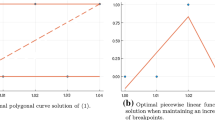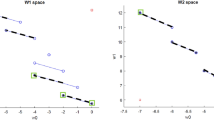Abstract
We consider a production planning problem where the production process creates a mixture of desirable products and undesirable byproducts. In this production process, at any point in time the fraction of the mixture that is an undesirable byproduct increases monotonically as a function of the cumulative mixture production up to that time. The mathematical formulation of this continuous-time problem is nonconvex. We present a discrete-time mixed-integer nonlinear programming (MINLP) formulation that exploits the increasing nature of the byproduct ratio function. We demonstrate that this new formulation is more accurate than a previously proposed MINLP formulation. We describe three different mixed-integer linear programming (MILP) approximation and relaxation models of this nonconvex MINLP, and we derive modifications that strengthen the linear programming relaxations of these models. We also introduce nonlinear programming formulations to choose piecewise-linear approximations and relaxations of multiple functions that share the same domain and use the same set of break points in the domain. We conclude with computational experiments that demonstrate that the proposed formulation is more accurate than the previous formulation, and that the strengthened MILP approximation and relaxation models can be used to obtain provably near-optimal solutions for large instances of this nonconvex MINLP. Experiments also illustrate the quality of the piecewise-linear approximations produced by our nonlinear programming formulations.










Similar content being viewed by others
References
Balakrishnan, A., Graves, S.C.: A composite algorithm for a concave-cost network flow problem. Networks 19(2), 175–202 (1989)
Beale, E.M.L., Forrest, J.J.H.: Global optimization using special ordered sets. Math. Program. 10(1), 52–69 (1976)
Beale, E.M.L., Tomlin, J.A.: Special facilities in a general mathematical programming system for non-convex problems using ordered sets of variables. Oper. Res. 69, 447–454 (1970)
Belotti, P., Lee, J., Liberti, L., Margot, F., Wächter, A.: Branching and bounds tighteningtechniques for non-convex MINLP. Optim. Methods Softw. 24(4–5), 597–634 (2009)
Borghetti, A., D’Ambrosio, C., Lodi, A., Martello, S.: An MILP approach for short-term hydro scheduling and unit commitment with head-dependent reservoir. IEEE Trans. Power Syst. 23(3), 1115–1124 (2008)
Burkard, R.E., Hamacher, H.W., Rote, G.: Sandwich approximation of univariate convex functions with an application to separable convex programming. Naval Res, Logist, 38, 911–924 (1991)
Camponogara, E., de Castro, M.P., Plucenio, A., Pagano, D.J.: Compressor scheduling in oil fields. Optim. Eng. 12(1–2), 153–174 (2011)
Dantzig, G.B.: On the significance of solving linear programming problems with some integer variables. Econ. J. Econ. Soc., 28, 30–44 (1960)
Geissler, B., Martin, A., Morsi, A., Schewe, L.: Using piecewise linear functions for solving MINLPs. In: Lee, J., Leyffer, S. (eds.) Mixed Integer Nonlinear Programming, vol. 154 of the IMA Volumes in Mathematics and its Applications, pp. 287–314. Springer, New York (2012)
Geoffrion, A.M.: Objective function approximations in mathematical programming. Math. Program. 13(1), 23–37 (1977)
Goldberg, N., Kim, Y., Leyffer, S., Veselka, T.D.: Adaptively refined dynamic program for linear spline regression. Technical Report Preprint ANL/MCS-P3040-0912, Argonne National Laboratory (2012)
Gupta, V., Grossmann, I.E.: An efficient multiperiod MINLP model for optimal planning of offshore oil and gas field infrastructure. Ind. Eng. Chem. Res. 51(19), 6823–6840 (2012)
Imamoto, A., Tang, B.: Optimal piecewise linear approximation of convex functions. In: Proceedings of the World Congress on Engineering and Computer Science, pp. 1191–1194 (2008)
Iyer, R.R.: Optimal planning and scheduling of offshore oil field infrastructure investment and operations. Ind. Eng. Chem. Res. 37(4), 1380–1397 (1998)
Lee, J., Wilson, D.: Polyhedral methods for piecewise-linear functions I: the lambda method. Discrete Appl. Math. 108(3), 269–285 (2001)
Markowitz, H.M., Manne, A.S.: On the solution of discrete programming problems. Econ. J. Econ. Soc., 25, 84–110 (1957)
Martín, M., Grossmann, I.E.: Energy optimization of hydrogen production from lignocellulosic biomass. Comput. Chem. Eng. 35(9), 1798–1806 (2011)
Orero, S.O., Irving, M.R.: A genetic algorithm modelling framework and solution technique for short term optimal hydrothermal scheduling. IEEE Trans. Power Syst. 13(2), 501–518 (1998)
Padberg, M.W., Rijal, M.P.: Location, Scheduling, Design and Integer Programming, vol. 19. Kluwer Academic Norwell, Dordrecht (1996)
Rote, G.: The convergence rate of the sandwich algorithm for approximating convex functions. Computing 48, 337–361 (1992)
Sridhar, S., Linderoth, J., Luedtke, J.: Locally ideal formulations for piecewise linear functions with indicator variables. Oper. Res. Lett. 41(6), 627–632 (2013)
Tarhan, B., Grossmann, I.E., Goel, V.: Stochastic programming approach for the planning of offshore oil or gas field infrastructure under decision-dependent uncertainty. Ind. Eng. Chem. Res. 48(6), 3078–3097 (2009)
Tawarmalani, M., Sahinidis, N.V.: Global optimization of mixed-integer nonlinear programs: a theoretical and computational study. Math. Program. 99(3), 563–591 (2004)
Van Den Heever, S.A., Grossmann, I.E.: An iterative aggregation/disaggregation approach for the solution of a mixed-integer nonlinear oilfield infrastructure planning model. Ind. Eng. Chem. Res. 39(6), 1955–1971 (2000)
Van Den Heever, S.A., Grossmann, I.E., Vasantharajan, S., Edwards, K.: Integrating complex economic objectives with the design and planning of offshore oilfield infrastructures. Comput. Chem. Eng. 24(2), 1049–1055 (2000)
Vielma, J.P., Ahmed, S., Nemhauser, G.: Mixed-integer models for nonseparable piecewise-linear optimization: unifying framework and extensions. Oper. Res. 58(2), 303–315 (2010)
Vielma, J.P., Keha, A.B., Nemhauser, G.L.: Nonconvex, lower semicontinuous piecewise linear optimization. Discrete Optim. 5(2), 467–488 (2008)
Acknowledgments
We thank Stephen J. Wright for several suggestions that helped improve this work, and we thank Ignacio Grossmann for bringing the reference [12] to our attention. We are grateful to the anonymous referees for suggestions that helped improve the paper.
Author information
Authors and Affiliations
Corresponding author
Appendices
Appendix 1
1.1 Production functions
We normalized the range of the total production function so that the cumulative production variable \(v\) has takes values in \([0,1]\). We used bounded, concave production functions of the form \(f(x) = r_0 + r_1x + r_2x^2\) with \(r_2 < 0\). We randomly generated \(f(\cdot )\) by choosing \(r_0 \sim \hbox {U}(15,25), r_2 \sim \hbox {U}(-50,0)\) and \(r_0 + r_1 + r_2 \sim \hbox {U}(-15,0)\). This procedure was repeated to generate independently and identically distributed samples of production functions \(f_i(\cdot )\) for each facility \(i \in \mathcal {I}\). The family of functions generated by this procedure always ensures that \(f(\cdot )\) is concave.
For each product \(p \in \mathcal {P}\), we must generate either a monotonically increasing or decreasing function. Additionally, we must ensure that \(\sum _{p \in \mathcal {P}}g_{p}(v) = 1, \forall v \in [0,1]\). We simulated such functions by scaling and translating a randomly generated function from a family of functions. One such family of monotonically increasing functions is \(\hat{g}(v) = \int \nolimits _0^v u^k(1-u)^k du / \int \nolimits _0^1 u^k (1-u)^k du, k=\{1,2,3\}\). We chose this family of functions because (a) it was rich enough to express productions functions of different kinds, (b) these functions are monotonically increasing, and (c) these functions satisfy \(\hat{g}(0) =0\) and \(\hat{g}(1) = 1\). We then obtain functions \(g_p(v), p \in \mathcal {P}\) by choosing positive real numbers \(a_p\) and \(b_p\) for \(p \in \mathcal {P}\) and then setting
Since the family of generated functions must satisfy \(\sum _{p \in \mathcal {P}}g_{p}(v) = 1, \forall v \in [0,1]\), we require
where \(a_p = g_p(0)\) and \(b_p = g_p(1)\). Additionally, we must also ensure that
which makes the useful product ratio functions decreasing and the byproduct ratio function increasing. The following sampling procedure generates product ratio functions which satisfy all the required conditions.
-
We sampled \(\hat{a}_p \sim \hbox {U}(0.8,1), p \in \mathcal {P}^{+}\) and \(\hat{a}_p \sim \hbox {U}(0,0.2), p \in \mathcal {P}^{-}\).
-
We normalized the above samples so that \(a_p = \frac{\hat{a}_p}{\sum _{p \in \mathcal {P}}\hat{a}_p}, \forall p \in \mathcal {P}\) which ensures that condition (33a) is satisfied.
-
Next, we sampled \(\hat{b}_p \sim \hbox {U}( 0, \frac{a_p}{2}) \ p \in \mathcal {P}^{+}\) and \(\hat{b}_p \sim \hbox {U}( 2a_p,1) \ p \in \mathcal {P}^{-}\) which ensures that conditions (33c) and (33d) are satisfied.
-
We normalized the above samples so that \(b_p = \frac{\hat{b}_p}{\sum _{p \in \mathcal {P}}\hat{b}_p}, \forall p \in \mathcal {P}\) which ensures that condition (33b) is satisfied.
1.2 Customer demands
We generated increasing demand profiles as follows. For each customer \(j \in \mathcal {J}\) and product \(p \in \mathcal {P}\), we randomly generated a demand time frame uniformly from start-time between \([1, \frac{T}{3}]\) and end-time between \([\frac{2T}{3},T]\). We generated demands \(\{d_{jpt}\} \sim \hbox {U}(0.8,1.2)\) for each time period within the demand time frame, sorted them in increasing order and scaled them by \(\frac{\sum _{i \in \mathcal {I}} \sum _{p \in \mathcal {P}^{+}}h_{ip}(1)}{3|\mathcal {J}|}\). Here, \(h_{i,p}(1)\) is the cumulative production of each useful product \(p \in \mathcal {P}^{+}\) from a facility \(i \in \mathcal {I}\). The scaling ensures that the total demand across all customers is roughly a third of the total possible production of useful products over all facilities.
1.3 Costs
We used the following procedure to generate the four different types of costs incurred at each facility. This procedure ensured that at the end of the planning horizon, the total facility opening cost is of the same order as the sum of operating, production and penalty costs. For each customer \(j \in \mathcal {J}\), facility \(i \in \mathcal {I}\) and product \(p \in \mathcal {P}\) during the first time period, we generated operating costs \(\beta _{i,p,1} \sim \hbox {U}(0.8, 1.2)\), transportation costs \(\gamma _{ijp1} \sim \hbox {U}(0.8, 1.2)\), penalty costs \(\delta _{j,p,1} \sim \hbox {U}(16, 24)\) and fixed costs \(\alpha _{i1} \sim \frac{\sum _{p \in \mathcal {P}^{+}}h_{ip}(1)}{3|\mathcal {J}|}\hbox {U}(0.8, 1.2)\). We discounted costs at 5 % for subsequent time periods.
Appendix 2: Detailed computational results
We now provide additional details of the computational results described in Sect. 5 of the manuscript. Tables 7, 8, 9 and 10 provide detailed computational results for the experiments performed on the 36 large instances of \( PP \)-\(\mathrm {MINLP2}\). Tables 7 and 8 illustrate the effect of formulation strengthening on the linear programming relaxation gaps of the MILP formulations of \(\mathrm {MINLP2}\), and were used to generate the summary statistics displayed in Fig. 9 and Table 3 of the manuscript, respectively. Table 9 shows feasible solution quality of the MILP approximation and relaxation schemes (\(\mathrm{PLA}\text {-}\mathrm{SS}, \mathrm{SEC}\text {-}\mathrm{S}\) and \(k\text {-}\mathrm{SEC}\text {-}\mathrm{SS}\)) by measuring the percentage gap to the best known solution bound of \( PP \)-\(\mathrm {MINLP2}\). Table 10 measures solution bound quality of the MILP relaxation schemes (\(\mathrm{SEC}\text {-}\mathrm{S}\) and \(k\text {-}\mathrm{SEC}\text {-}\mathrm{SS}\)) using the percentage gap to the best known solution feasible solutions of \( PP \)-\(\mathrm {MINLP2}\). Tables 9 and 10 were used to construct summary statistics for Table 4 in the manuscript.
Rights and permissions
About this article
Cite this article
Sridhar, S., Linderoth, J. & Luedtke, J. Models and solution techniques for production planning problems with increasing byproducts. J Glob Optim 59, 597–631 (2014). https://doi.org/10.1007/s10898-014-0167-1
Received:
Accepted:
Published:
Issue Date:
DOI: https://doi.org/10.1007/s10898-014-0167-1




